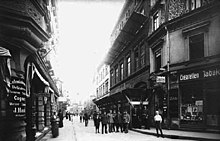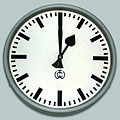Carl Theodor Wagner
| Carl Theodor Wagner Electrotechnical Factory
|
|
|---|---|
| legal form | Since 1923 AG later production GmbH |
| founding | 1852 |
| resolution | 1977 |
| Seat | Wiesbaden |
| management | Last managing director: Ernst Wagner |
| Branch | Electrical engineering |
Carl Theodor Wagner (born May 20, 1826 in Usingen , † March 28, 1907 in Wiesbaden ) was a German master watchmaker and entrepreneur.
Life
Carl Theodor Wagner completed an apprenticeship as a watchmaker in his hometown, worked as a journeyman in Frankfurt am Main and Mannheim and learned the principles of electromagnetism from Professor Meidinger in Heidelberg . In 1852 he opened a workshop in Usingen and began producing electrical clock systems . Wagner was sponsored by Duke Adolf , who let him travel to the world exhibitions in 1862 and 1863 and also made sure that he moved the company headquarters to Wiesbaden.
From 1863 the workshop was initially in Goldgasse. In 1885 the factory moved to Mühlgasse (then No. 4). After Wagner's retirement from business life, his sons continued the company. In 1915 C. Theod. Wagner Elektrotechnische Fabrik has its headquarters again. The expanding company moved from downtown Wiesbaden to Schiersteiner Strasse 31-33 on the outskirts of the city at the time, to a newly built production building with residential and commercial buildings.
Clock systems
Clock systems consisted of a master clock (mother clock) and any number of slave clocks (daughter clocks) without a timing mechanism, which received electrical jump pulses from the master clock every minute and thus displayed the same time. Pole-reversing direct current pulses were used for transmission, often over long overhead lines along the railway lines. By reversing the direction of the current from minute to minute, it was possible to compensate for additional false impulses, in that the daughter watch ignored the next control impulse and did not jump on until the following minute. Incorrect impulses could result from induction as a result of a lightning strike in parallel lines. The change in polarity also prevented the electromagnetic components of the slave clocks from magnetizing themselves over time with always the same polarity, making the display unreliable.
Further products
In addition to clock systems, according to an advertisement from the company from 1876/1877, CTW produced musical works, music boxes, house telegraphs, "electrical signal and bell devices according to our own invention and the most solid construction for hotels, mansions and factories", induction devices, galvanic batteries and "security -Apparatus against thieves ".
Patents
Together with the Kassel watchmaker Heinrich Grau, Wagner invented the Grau-Wagner system , which was one of the foundations of large clock production by the Wagner company , which existed until 1977. It improved the operational safety of clock systems by means of a so-called safety catch, which ensured the direction of rotation of the stepping mechanisms on slave clocks and blocked the skipping of a minute with a second (patent from 1880 and 1881 to Heinrich Grau).
In 1879 he got the patent for an electrical device for generating slow strikes on electric bells , which enabled the operation of automatically striking church tower clocks.
Spread of clocks
The founding period was the heyday of the plant, which at times supplied customers worldwide. From 1880 the Grau-Wagner-Werke were the main supplier of clock systems for various state and private railways in the German Empire . So owned z. For example, Frankfurt Central Station has a Wagner system with around 50 slave clocks. With the advent of quartz watches in the 1960s, the company ran into difficulties and in the end only produced products for customers like Siemens and Standard Elektrik Lorenz before it had to file for bankruptcy.
CTW slave clock with dial with "DIN bar" and "heart pointer"
literature
- Hans-Heinrich Schmid : "Lexicon of the German watch industry 1850–1980: company addresses, production program, company logos, brand names, company histories." (3rd expanded edition 2017); Editor: German Society for Chronometry eV; ISBN 978-3-941539-92-1
- Margrit Spiegel: Wiesbaden company letterheads from the imperial era 1871-1914. Wiesbaden 2003, pp. 144-147. ISBN 3-9808702-0-0
- Article in the Rhein-Main-Presse by Manfred Gerber on July 6, 2000: Wiesbaden once delivered watches all over the world
Web links
- H. Grau and Th. Wagner's electric clock. In: Polytechnisches Journal . 251, 1884, pp. 492-494. (Description of the safety gear of the Grau-Wagner design, with illustration)
- Brochure “Route of Industrial Culture”, Rhein-Main, Wiesbaden I, Local Route Guide NR. 4, "18 Objects of Industrial History", Item No. 9 (PDF; 421 kB)
- Article about the electrotechnical works of Carl Theodor Wagner on Watch-Wiki
- Technical details about the pole reversing switch at elektrouhr.de
Individual evidence
-
↑ German Patent No. 13289 of July 29, 1880: Electric pointer movement with rotating armature movement and polarized armature , submitter / inventor: Heinrich Grau, Cassel
German Patent No. 18057 of November 8, 1881: Innovations in the under No. 13289 patented hand movement with rotating armature movement and polarized armature , submitter / inventor: Heinrich Grau, Cassel
Remarks
- ↑ not the main supplier of the Deutsche Reichsbahn , this was only founded in 1920.
| personal data | |
|---|---|
| SURNAME | Wagner, Carl Theodor |
| BRIEF DESCRIPTION | German master watchmaker and entrepreneur |
| DATE OF BIRTH | May 20, 1826 |
| PLACE OF BIRTH | Usingen |
| DATE OF DEATH | March 28, 1907 |
| Place of death | Wiesbaden |







